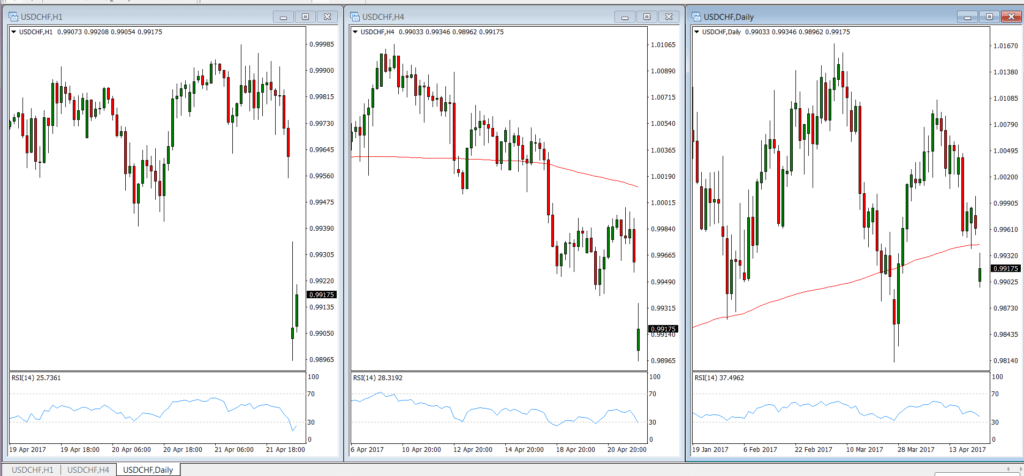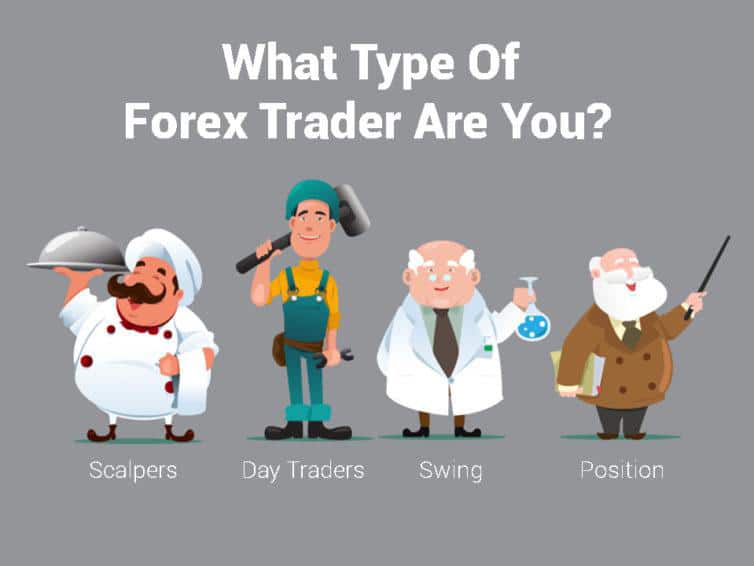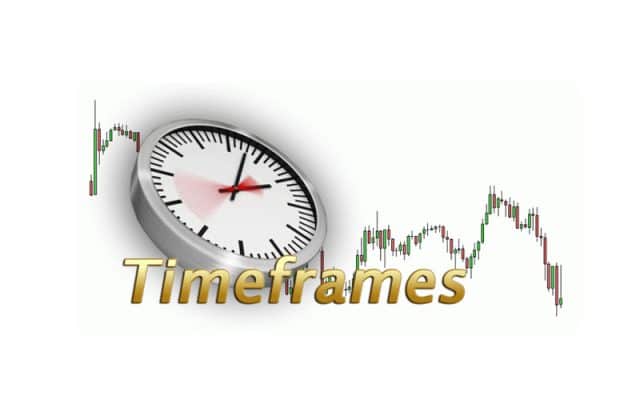Introduction to forex timeframes

In forex, any technical chart represents where price has moved over a specific period. Timeframes refer to the unit of time responsible for forming a collection of candles or ticks on a chart. So, to illustrate, the D1 (daily) timeframe displays all the daily candles where each candle took 24 hours/1 day to form. The creation of a new candle on this timeframe will take another day to materialize, and so on.
The number of timeframes available to traders has increased over the years with the introduction of newer and more sophisticated trading platforms. However, a vast majority of the industry naturally gravitates towards timeframes featured on MetaTrader 4 due to the immense popularity of the software. MT4 consists of 9 timeframes, namely M1 (1 minute TF), M5 (5 minute TF), M15 (15 minute TF), M30 (30 minute TF), 1HR (1 hour TF), 4HR (4 hour TF), D1 (1 day TF), W1 (1week TF) and MN (monthly TF).

Perspective matters. All a timeframe provides is perspective. Some traders hold very, very short-term perspectives (seconds to minutes); other traders hold medium-term perspectives (hours), and others hold long-term perspectives (days, weeks, months, and years). With a short-term perspective, a trader needs intense concentration in tackling the volatility of the forex markets more frequently. The higher the timeframe, the less noisy the markets are. In choosing a timeframe, a trader is merely choosing which amount of noise they are comfortable dealing with relative to how much time they have to trade, their trading strategies, and overall trading philosophies.
Aligning timeframes according to a trading style
Traders who have a very set methodology and trading strategy choose the most appropriate timeframes that align with who they are. Just as we, humans, are very diverse, what’s best for one won’t be best for another. The same logic applies to timeframes.
On the whole, the higher the timeframe, the more patience one has to possess. Thus, the critical thing about selecting a timeframe ultimately comes down to patience. Smaller timeframes are suitable for traders who are less patient, while higher timeframes are suitable for more patient traders. Generally speaking, traders fall into four distinct groups. These distinctions provide a very reliable framework that traders can use in opting for the most beneficial timeframe for themselves.
The four groups are:
- Scalpers
- Day traders
- Swing traders
- Position traders

While all traders primarily perform the same job, their hold times vary substantially. Scalpers are traders who aim to profit off very tiny price fluctuations repeatedly within a market session. As a result, the hold time for their trades is usually seconds to a few minutes.
Day traders aim to profit off daily price movements by holding their trades for hours and closing them out before the next day. Swing traders attempt to ride out more extended market swings for a few days up to a few weeks. Position size traders are more extreme swing traders aiming to hold their positions for longer, from months to even years.
Each trader operates on a particular timeframe/s. Scalpers generally have to use 1M, 5M, and 15M charts to capture small movements since these timeframes allow for this type of trading style. Even though these timeframes are considered noisy due to their erratic behavior, scalpers thrive off that noise. It is almost impossible to scalp on a timeframe higher than these because the market structure wouldn’t allow for quick profits.
At the extreme end, some traders employ somewhat of a ‘buy and hold’ philosophy, where they can endure holding positions for exceptionally long periods, at least a month. They would operate on much bigger timeframes starting from the D1 to the MN because the rare opportunities for very long-term trade ideas are more visible here. As a rule of thumb, smaller timeframes offer many more trading opportunities, albeit with smaller profit targets. The higher the timeframe, the less frequent the number of trades, though the profit potential can be substantial since you’d be aiming for larger targets.
| Trader style | Holding time | Preferred timeframes | Average amount of pips for profit target |
| Scalper | Seconds to minutes | 1M, 5M, 15M | 1-20 |
| Day trader | Hours up to the close of the day | 30M, 1HR | 20-50 |
| Swing trader | A few days to a few weeks | 4HR, D1 | 100+ |
| Position trader | At least a month up to years | W1, MN | 300+ |
Analysis across multiple timeframes
A multi timeframe approach can take on various forms. The most common one involves observing a long-term trend on timeframes ranging from the D1 and then observing short-term trends on lower timeframes. Depending on the analysis and strategy used, a trader could first confirm a market is in an uptrend on three different timelines before buying. The logic behind this approach would be to enter as optimally as possible. In this scenario, the trader hopes that the market won’t retrace for too long against their position due to the counter-trends that may occur on smaller timeframes. Many other approaches have similar objectives to increase profitability and for better entries.
In-depth Technical Analysis: Forex Indicators + Multiple Timeframes
Another approach to a multi timeframe approach can be utilized by traders that trade momentum indicators. One of the main features of popular oscillators such as the stochastics and RSI is the overbought and oversold features. These features reflect extended uptrends and downtrends, respectively. However, in many cases, while all timeframes may, for example, not be overbought/sold, there might be one other timeframe that still exhibits this event. This bit of information could give the trader a good clue as to the potential for the bigger trend to continue.
Conclusion
Every market participant has different objectives and patient levels. Some cannot stand to hold a position for very long, and since they might have more time to look at charts, their objectives will lean towards quicker profits. Other traders may lead a busier life and would need to select a higher timeframe to complement this lifestyle. As a compromise, they accept to be more patient with how long they intend to stay in their positions and that quick profits won’t be possible. One of the keys to being a successful trader is striking a balance with all of these considerations in mind and picking the best timeframe that is right for you.




